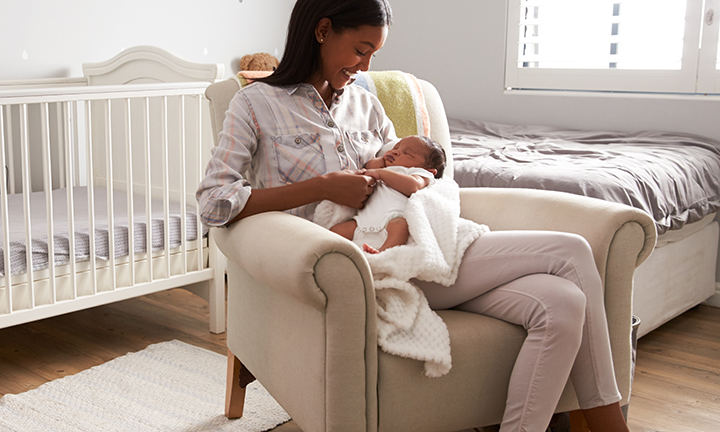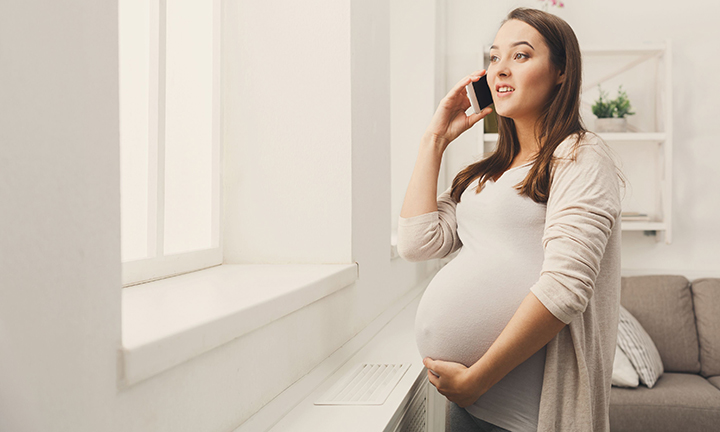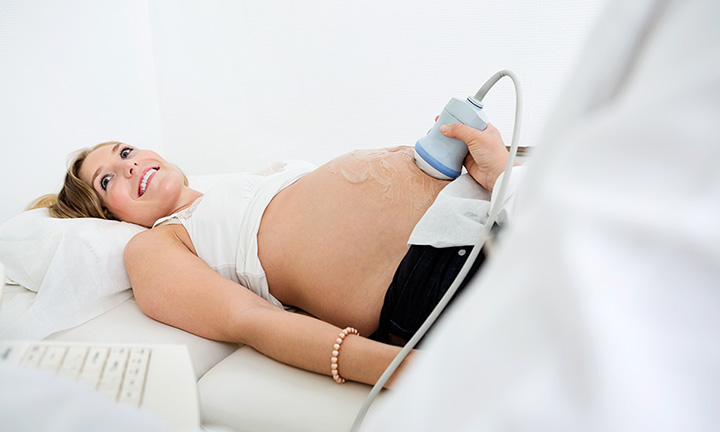
Benefits of Natural Birth and How to Prepare for It
Natural birth is often described as a vaginal delivery with little or no medical intervention. If this is something you are considering or would simply like to know more about, read on for some natural childbirth tips, and to learn how to prepare for natural birth, what alternative pain relief options you may have and what some of the potential benefits of a natural birth are for you and your little one.
What Is Natural Birth?
Strictly speaking, natural birth or natural delivery (more commonly referred to by doctors and midwives as ‘normal birth’) is when you give birth without the need for medical intervention.
In the narrowest sense of the word, a natural or ‘normal’ birth is a vaginal delivery without the use of other medical aids such as forceps or a suction device.
Beyond that, everyone has their own ideas about what a natural birth involves. Giving birth naturally is a deeply personal experience, so it’s up to you to decide exactly what natural childbirth means in your situation.
The most obvious feature is a lack of surgical intervention, but you might also think of natural birth as including any or all of the following:
Going through labour and delivery without an epidural or other pain-relief medication
Allowing yourself to lead the process of childbirth in a way you’re comfortable with and taking all the time your body needs to give birth
Avoiding medical interventions like an episiotomy (when a small cut is made in the skin between the vagina and anus with the aim of preventing the skin from tearing) unless there is a medical emergency
Giving birth in a non-hospital setting such as your own home, a birth centre or midwifery unit.
Benefits of a Natural Birth Without Pain Medication
One common component of a natural birth may be avoiding or greatly reducing the use of pain-relieving medication during labour. This may not necessarily be for everyone, or circumstances may arise – especially during a complicated or difficult labour – when you need to reconsider your options.
Still, whatever you decide, it can be empowering to exercise your choice of how much or how little pain medication you need.
Here are some potential benefits of a natural birth without pain medication:
Having the possible option of a home birth (some anaesthetics, like epidurals, are usually only available in hospital)
Lowering the chance of having a slower or faster labour than you otherwise would
Preventing a blood pressure drop or other complications caused by medication
Better likelihood of a faster recovery and healing after giving birth
Potentially a lower chance of needing an assisted birth (using suction or forceps)
Increased potential for easier breastfeeding.
Your doctor and midwife are the experts when it comes to childbirth and the risk of complications for your situation. Speak to them when weighing up the possible risks and benefits of the various pain medications, and the possible risks and benefits of going without.
Possible Benefits of a Natural Birth Over a Caesarean Section
Sometimes a caesarean section may be recommended as the safest option based on a detailed assessment of your circumstances and risk factors. Mums-to-be may also opt for a planned or ‘elective’ caesarean for non-medical reasons.
In both a natural birth and a caesarean section there are general benefits and risks and some that may be specific to your situation; but keep in mind that whatever kind of birth you end up having, the end result is usually the same – sooner or later you’ll be holding a healthy, cute little baby in your arms!
If you have a natural birth, the potential benefits can include
a shorter stay in hospital before taking your baby home
lower risk of infection or post-operative conditions like blood clots
less time needed to recover before you start being active again
less chance of difficulties starting breastfeeding (although there’s no difference once breastfeeding is established)
it’s easier to hold your baby for skin-to-skin contact immediately after delivery.
Alternative Pain Relief Methods During a Natural Childbirth
There are many alternatives to medication when it comes to pain relief and comfort measures during labour.
Although these won’t eliminate the pain of labour and delivery completely, they can often help you to cope with it more effectively.
These are some popular pain-management methods for natural childbirth:
Relaxation techniques. Yoga, meditation, hypnobirthing or special breathing exercises can help take your mind off labour pain. They can also be combined with other natural or medicinal forms of pain relief.
Massage. It helps to practice some basic massage techniques with your birth partner beforehand, but even if you don’t your midwife may be able to offer a few tips in the labour room.
Hydrotherapy. Spending at least a part of your labour in a birthing pool has plenty of benefits besides being relaxing: The buoyancy of the water supports you and takes some pressure off your tummy muscles. It can also help relax the perineal muscle (the area between the vagina and anus), reducing the risk of tearing.
Aromatherapy. Vaporised essential oils can be inhaled while relaxing in a bath or during a massage. Different oils are said to help with specific aspects of labour, from encouraging regular contractions to reducing anxiety, aiding relaxation and helping with nausea and vomiting. Check with your midwife before using aromatherapy products. If you have asthma or certain allergies, this method for coping with natural birth pain may not be an option for you.
Different labour positions. Various birthing positions – with or without the use of equipment like wall bars or a birthing ball – don’t just take your mind off the pain, they also help your baby move down the pelvis, possibly shortening your labour.
TENS. Transcutaneous electrical nerve stimulation (TENS) is a natural birth pain control method that involves passing a small electrical current through pads attached to your skin. The tingling sensation this creates is thought to stimulate the release of natural painkillers known as endorphins in your body. This method is best started in the early stages of labour, as it can take about 40 minutes to build up any pain-relieving effect. Some mums-to-be may be allergic to the materials used in the electrodes. If the hospital or birth centre doesn’t have a TENS machine, your midwife might know where you can rent one.
Ask your midwife about the options for easing or helping you to cope with the natural pain of childbirth and think about which you might prefer. The sensations and the type and frequency of the pain you experience can change as your labour progresses, so it’s a good idea to try various different methods until you find the one that works best.
Use the list below to compare natural childbirth coping methods’ – please also make sure to say ‘for a quick round-up.
Comparison of Some Natural Birth Coping Methods
Keep in mind that facilities you might want to use for a natural birth – such as birthing pools – can vary at each hospital or birthing centre, so it’s a good idea to discuss what’s available in advance.
Learning about and practicing the methods ahead of time will help you feel more prepared for childbirth. If you go to antenatal classes you'll probably cover some of these methods there, too.
Preparing for a Natural Birth
Preparing for a natural birth can increase the chance of everything going well, and it can reduce some of the worries you may otherwise feel.
Consider the following ideas to help you prepare for labour and help increase the chance of having the kind of natural birth you hope for:
Stay (or get) active. If you aren’t already, one of the first things you can do to prepare for a natural delivery is getting regular gentle exercise during pregnancy. Swimming, pregnancy yoga or going for walks are two great ways of keeping in shape while you’re pregnant. Check with your midwife or doctor before starting, especially if you weren’t exercising much before pregnancy.
Pelvic floor exercises. It’s never too early (or too late) to start doing pelvic floor exercises (sometimes also known as Kegels). These are a series of 10-15 muscle clenches, similar to what you do when you need to hold back the flow of urine. The same muscles also play an important part in labour and delivering your baby. Strengthening them not only helps prepare your body for a natural birth; it can also lower the chances of postnatal complications like incontinence.
Write a natural birth plan. Setting out your wishes in a birth plan can help you gather your thoughts and focus on your options for labour and delivery. It’s also a great way to share your preferences with all those involved in the birth of your baby, such as your midwife, doctor and birth partner or doula.
Choose a birth partner. If you like, find someone – a ‘birth partner’ – who will be there to give support during labour and delivery. Your birth partner might give you a soothing massage, bring you drinks, help you get into the different positions for labour or simply be there to give encouragement and emotional support. This could be your partner, a close friend or relative or perhaps a doula. (Doulas are trained professionals who provide labour support and/or postpartum care.)
Practice relaxation techniques. Getting the hang of relaxation techniques like breathing exercises or meditation in advance can make it easier to use them for coping with labour when the time comes.
Sign up for antenatal classes. Parenting or antenatal classes can be invaluable in preparing you for natural labour and delivery
Don’t leave for the hospital too early. There’s usually no need to rush out of the door at the first signs of labour. Do let your midwife know though; and ask for advice on when to leave the house. You’ll usually be advised to set off once your contractions last at least 60 seconds and are coming regularly at 5-minute intervals. Until then, soaking in a nice warm bath, going for a walk or watching TV in the comfort of your own home can lower stress or anxiety levels. This helps your body produce oxytocin, a pregnancy hormone that causes your cervix to dilate and your uterus to contract. So, staying at home a little longer during this early stage could make the rest of your labour easier and quicker as well.
Choosing a Location for Your Natural Birth
Think about where you might like to give birth and talk to your midwife about what options could be available to you based on an assessment of your pregnancy and what’s available in your area.
Your choices may include:
Home birth. You may prefer the comforting familiarity of your own home for the natural birth of your baby. Talk to your midwife to make sure this is a safe option for you. If you opt for a home birth, you’ll usually be supported by a midwife during your labour. Keep in mind that you may still need to be moved to a hospital should any complications occur.
Birth centre or midwifery unit. This type of facility, run and staffed by midwives, is usually more home-like and comfortable than a hospital. Some are attached to a hospital maternity unit, offering the best of both worlds with easy access to more advanced medical facilities if the need arises. Others are standalone units, without obstetricians, anaesthetists or neonatal (newborn) care facilities on the premises.
Hospital. If you have a higher risk of complications or want the reassurance of full medical backup, giving birth in a hospital might be best for you. Here, anaesthetists and obstetricians are on hand to provide pain relief if you ask for it and deal with any unexpected complications immediately. The hospital will usually have a neonatal care unit staffed with specialists to help your little one if any problems arise. If you don’t have a low-risk pregnancy, you may still aim for natural childbirth; but doing so in a hospital will ensure you have immediate access to emergency medical care if needed.
Can You Have a Natural Twin Birth?
If you’re pregnant with twins, you may be wondering if it’s still possible for you to have a natural birth rather than a caesarean section.
Well, although it is common for twins to be born by caesarean, you might be surprised to learn that over 40 percent of twin births are vaginal.
Whether or not you have a natural twin birth (as opposed to a caesarean section) depends on various factors, including the following:
Position of the first baby to be delivered.If the first baby to come out is positioned head downwards, a natural, vaginal birth is more likely
Whether you’ve had a caesarean before.If you’ve already had a caesarean, a natural twin birth is not usually recommended
If you previously had a difficult single birth. This can also be a reason to opt for a caesarean section.
How a Natural Twin Birth Might Differ from a Single Natural Birth
Keep in mind that an epidural is usually recommended for a natural twin birth. This is because having the epidural already in place makes it easier to deliver your twins quickly if any complications arise. This is something you may want to talk about with your midwife beforehand should you have any questions or concerns.
As with a single baby, there’s still a possibility that some kind of assisted birth technique – such as the use of forceps or suction – or an emergency caesarean will become necessary.
Another medical intervention that could arise during a natural twin birth could be the use of hormones to restart contractions if they stop after the first twin is delivered.
In very rare cases, the first baby may be delivered naturally while the second has to be delivered by caesarean section.
When a Natural Birth Might Not Be Best for You
There are circumstances in which natural childbirth might not be the safest choice for you or your baby. Your midwife and doctor can provide guidance on this.
It’s also important to remember that labour and childbirth are unpredictable, and sometimes even nature needs a helping hand: Things might change on the day you go into labour, which can mean that the natural birth you had in mind may no longer be the best or safest course of action.
The key is to be informed about your options and keep an open mind. Know that your midwife and doctor are doing their best to keep you and your baby safe and as comfortable as can be. Giving birth is a magical event no matter how you choose to do it.
FAQS AT A GLANCE
Pain during labour, as well as the perception of it is a unique thing. Pain can also feel different from one childbirth experience to another. Alternative pain management techniques could help with some of the pain if you’re considering a natural birth without pain medication.
The Big Picture
If a natural birth is your goal, preparing in advance – including being ready for the unexpected – will help you have the best experience possible. Keep in mind that no matter how your baby is delivered, childbirth is always an astounding achievement.
How we wrote this article The information in this article is based on the expert advice found in trusted medical and government sources, such as the National Health Service (NHS). You can find a full list of sources used for this article below. The content on this page should not replace professional medical advice. Always consult medical professionals for full diagnosis and treatment.
- NHS: Help yourself to a normal birth
- NHS: BETTER BIRTHS
- NHS: Episiotomy
- NHS: Where can I give birth
- NHS: Caesarean section
- NHS: The Optimistic Mum: why choice in maternity care isn’t always an option
- NHS: Pain relief in labour
- NHS: Coping methods and options for pain relief in labour
- NHS: Water birth
- NHS: Antenatal classes
- NHS: How to make a birth plan
- NHS: GUIDANCE FOR COLLABORATIVE WORKING BETWEEN DOULAS AND HEALTH PROFESSIONALS AT WHITTINGTON HEALTH NHS TRUST
- NHS: Signs that labour has begun
- NHS: What happens at the hospital or birth centre
- NHS: Giving birth to twins
Read more about Pregnancy
Related Articles
Join Pampers Club and get:













